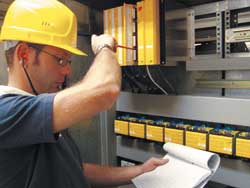
Posted to News on 8th Nov 2008, 15:00
Competency management for machinery safety
Dave Anderson, a consultant with Pilz who also manages the Pilz global competency management scheme, explains what is required to manage competency in the context of machinery safety.

Competency is a concept that is often misunderstood, but current health and safety regulations mean that it is important to operate a formalised competence management scheme. Indeed, the Health and Safety Executive (HSE), in partnership with the Institution of Engineering Technology (IET) and the British Computer Society (BCS), has published guidance on managing the competence of staff involved with electronic safety-related systems - which includes safeguarding machinery and industrial automation.
IEC 61508 (Functional safety of electrical/electronic/programmable electronic safety related systems), for example, requires personnel working on electrical, electronic or programmable electronic safety-related systems to be competent to perform the task required of them, and it must be possible to demonstrate this competency. Because of the critical nature of competency, it is advisable for companies to manage the competency of their staff and the organisation as a whole, which implies that individuals need to be assessed under an appropriate management process.
Pilz Automation Technology has developed and implemented its own competency management scheme that includes competency models, competency maps, an assessment programme and a competency management system. Many client companies have already benefited from this scheme being adapted to suit their own requirements.
Competency models
At the heart of the Pilz competency management scheme are competency models for each engineer and consultant. A competency model is essentially a list of competencies that are needed to perform a job effectively. It is not expected that the individual will already have achieved all of the competencies in the model, but there should be challenging yet achievable goals.
There are three aspects to competency, namely knowledge, skills and attributes. Knowledge, for example, might relate to standards and regulations; skills could relate to the ability to design electrical schematics; and attributes would include teamworking and communications skills. Another way to look at the competencies is as task-related competencies (such as technical skills and knowledge) and function-related competencies (such as behavioural skills and an ability to work with others at all levels).
When comparing the engineer's competencies with the competency model there are three levels that can be achieved: knowledgeable, proficient and advanced. At the knowledgeable level the engineer will be able to demonstrate knowledge of the particular competence and an understanding of how the competence is used in the workplace, but will work under supervision.
If the engineer's competence is assessed as 'proficient', generally he or she can demonstrate a sound level of understanding of the required competence, will have sufficient experience and the confidence to work unsupervised.
In order to have a competence assessed as 'advanced', the engineer must be able to demonstrate a thorough understanding of the competence, will be capable of performing the competency fully and independently, and can act as an advisor, supervisor or trainer.
For each competency, there is a defined performance criteria and then two statements relating to a lower and upper level. Typically they will correlate to a technician and an engineer, or those who possess the knowledge and those who are also able to apply it.
Competency maps
While the above outlines the scheme implemented in-house at Pilz for its engineers and consultants, manufacturing organisations would most likely also manage the competency of managers, operatives and technicians. Note that competency models can be useful for managing human resources as well, such as when building profiles or job descriptions during recruitment campaigns, or when assessing staff for promotion.
Competency models are a means by which the individuals' required competencies can be identified and assessed. These are complemented by a competency map that shows the route from the existing competency level to the target competency, which is likely to include training courses.
An assessment of competencies is carried out by reviewing evidence presented by the candidate. The evidence may take the form of documentary evidence, a witness testimony, oral evidence, observation, skill tests or project work. Evidence can be assessed either subjectively or objectively. Note that the assessor does not need to be an expert, as expert witnesses can be called upon where appropriate, but the assessor must have the ability to identify and collect the evidence, as well as being in a position to advise on training and personal development.
Of course, the competence management system also requires that a verification process be used to ensure that the competence assessments and the results comply with defined criteria.
Management structures
Other important aspects of a competence management system include a management structure that allows the competency scheme to be reviewed to ensure that, for example, the competencies and range statements continue to reflect the company's requirements, and that the stated competency policy continues to operate in the required fashion.
Pilz can assist client companies as much or as little as required in the creation and implementation of competency management schemes. This can overcome the uncertainty associated with introducing a concept that is still new to many people, as well as allowing a competency scheme to be implemented with as little input from company personnel as possible, in the event of resources being limited. Alternatively, Pilz can take a hands-off approach, leaving the client company to carry out the majority of the work, with the Pilz consultant providing support only when necessary.
More information about competence, including free PDF copies of the recently published competence management guidance documents, is available on the HSE's website.






























